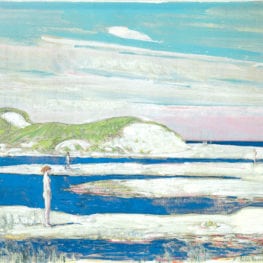Childe Hassam
1859-1935
Regarded as one of the foremost Impressionist painters in the United States, Childe Hassam was an artist for whom success came early, remained constant throughout his career, and continues to our present day. Hassam was born and raised in the Boston suburb of Dorchester in 1859, a time in which Boston’s cultural climate had attained a vibrancy to match that of New York and Philadelphia. Painting in Boston at this time centered on the collector Isabella Stewart Gardner and the Boston Museum School.
As a child, Hassam displayed significant talent as a draftsman. He planned a career in art early in life, but the financial collapse of his father’s merchant business forced him to leave high school at the age of seventeen to aid in the support of his family. He initially worked in the accounting department of a publishing company, but it was clear that his facility with numbers was not his strength. Spurred by his ambition, he left the publishing department and apprenticed with a wood engraver in 1876. He took evening classes at the Boston Art Club and studied art privately as well.
Hassam’s early aesthetic was shaped considerably by Boston’s leading artist of the time, William Morris Hunt (Hassam was related via his paternal grandfather to the Hunt family), who, in turn, had been inspired by the Barbizon School of painters (among the best known were Camille Corot, Jean-François Millet and Theodore Rousseau). In defiance of the academy, the Barbizon painters treated nature as a subject unto itself, without historicist or spiritual references; they included portraits of the common man at work, a subject deemed inappropriate for high art.
Hassam’s education continued with his first trip to Europe in 1883. He was exposed to an enormous array of art in England, France, Holland, Italy and Spain. Hassam’s first significant solo exhibition occurred in Boston upon his return from Europe. The artist showed watercolors indebted to both Hunt and the Barbizon painters. The show received excellent reviews. He returned to Europe in 1886 and took instruction at the Académie Julian, while exhibiting to considerable acclaim at the Salon and in private galleries. Returning to the United States in 1889 and settling in New York City, Hassam soon exhibited paintings that showed the influence of French Impressionism. His palette, previously muted in the earth tones of the Barbizon School, exploded with rapturous color. Yet his brushwork technique was more precise and focused than that of the French Impressionists.
His painting output was prodigious, but he also found time to write extensively and with eloquence in his championing of an American art. Hassam disavowed the received idea that his work was based solely on European art; he was an avid promoter that American painters were, at the very least, equals of contemporary Europeans. The predilection of many art collectors solely for European art was especially irksome to the artist, although he himself enjoyed a lifetime of critical acclaim and commercial success.

